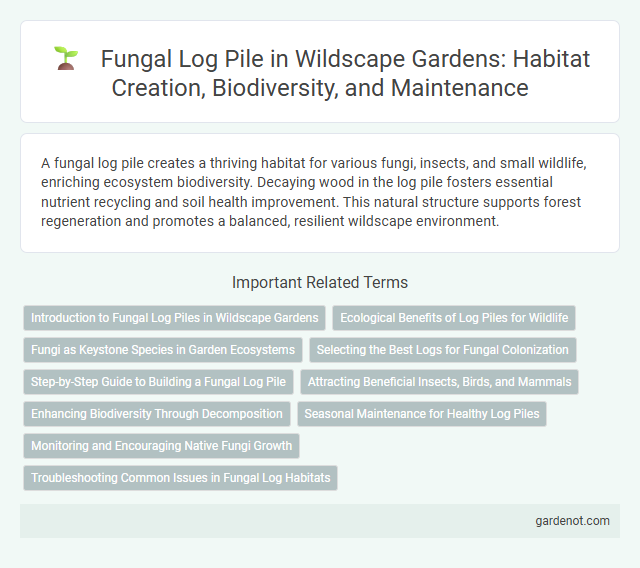A fungal log pile creates a thriving habitat for various fungi, insects, and small wildlife, enriching ecosystem biodiversity. Decaying wood in the log pile fosters essential nutrient recycling and soil health improvement. This natural structure supports forest regeneration and promotes a balanced, resilient wildscape environment.
Introduction to Fungal Log Piles in Wildscape Gardens
Fungal log piles in Wildscape Gardens create essential habitats that support diverse fungi species crucial for ecosystem health. These decomposing wood structures enhance soil fertility by breaking down organic matter and fostering beneficial microbial activity. Wildscape's fungal log piles also provide shelter and food sources for invertebrates, promoting biodiversity and natural pest control.
Ecological Benefits of Log Piles for Wildlife
Fungal log piles create essential habitats that support biodiversity by providing shelter and food sources for various insects, fungi, and small mammals. These decomposing logs enrich soil fertility through nutrient cycling, promoting healthier plant growth and ecosystem stability. By fostering fungal growth, log piles enhance mycorrhizal networks that aid plant root systems and contribute to forest regeneration.
Fungi as Keystone Species in Garden Ecosystems
Fungal log piles serve as vital keystone species in garden ecosystems by decomposing organic matter, enriching soil fertility, and supporting biodiversity through symbiotic relationships with plants and microorganisms. These fungi facilitate nutrient cycling, promoting healthy plant growth and sustaining diverse invertebrate populations. Integrating fungal log piles into wildscapes enhances ecosystem resilience and fosters balanced ecological interactions.
Selecting the Best Logs for Fungal Colonization
Choosing the best logs for fungal colonization in a wildscape involves selecting recently fallen hardwoods like oak, ash, or beech, which retain moisture and nutrients essential for mushroom growth. Logs should be free from chemical treatments and disease, ideally aged 6 to 12 months to promote optimal mycelium development. Positioning these logs in shaded, humid areas enhances fungal colonization and contributes to a thriving ecosystem.
Step-by-Step Guide to Building a Fungal Log Pile
Create a fungal log pile by stacking hardwood logs, such as oak or ash, in a shaded, damp area to promote mushroom growth. Drill holes in the logs and insert fungal spawn plugs or sawdust mixed with mushroom spores, then seal with wax to retain moisture and encourage colonization. Maintain the pile by periodically watering and covering it with a tarp or leaf litter to sustain optimal humidity for fungal development.
Attracting Beneficial Insects, Birds, and Mammals
A fungal log pile creates a rich habitat that attracts beneficial insects like beetles, woodlice, and spiders, which play crucial roles in pest control and nutrient cycling. Birds are drawn to the pile for the abundance of insects, enhancing local biodiversity and promoting seed dispersal. Mammals such as hedgehogs and small rodents use the log pile for shelter and foraging, supporting healthy garden ecosystems.
Enhancing Biodiversity Through Decomposition
Fungal log piles create essential habitats that boost biodiversity by accelerating organic matter decomposition and enriching soil nutrients. They support a diverse community of fungi, insects, and microorganisms, which play critical roles in breaking down wood and recycling nutrients within ecosystems. These piles foster a dynamic environment that sustains various wildlife species and promotes ecological balance in wildscapes.
Seasonal Maintenance for Healthy Log Piles
Seasonal maintenance of fungal log piles involves regularly clearing away debris and ensuring adequate moisture levels for optimal fungal growth. Removing old or decayed logs prevents the proliferation of unwanted pests while promoting healthy mycelium development. Properly maintained log piles contribute to biodiversity by supporting various saprophytic fungi throughout changing seasons.
Monitoring and Encouraging Native Fungi Growth
Regular monitoring of the fungal log pile involves assessing moisture levels, temperature, and fungal colonization stages to ensure optimal growth conditions for native species. Encouraging native fungi growth is achieved by selecting locally sourced wood, avoiding chemical treatments, and maintaining shaded, humid environments that mimic natural habitats. Periodic inspection helps identify beneficial fungi presence and prevents invasive species from disrupting the ecosystem balance.
Troubleshooting Common Issues in Fungal Log Habitats
Fungal log piles in wildscape environments often face issues such as poor moisture retention, leading to inhibited mycelium growth and reduced mushroom yield. Ensuring optimal humidity levels between 85-95% and proper air circulation prevents mold proliferation and fungal dieback. Applying a balanced layer of shredded leaves and maintaining shaded conditions promotes healthy fungal colonization and decomposition processes.
Fungal log pile Infographic

 gardenot.com
gardenot.com